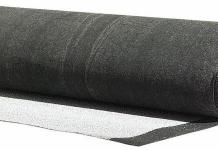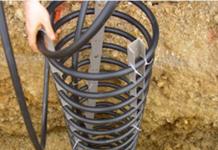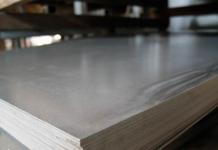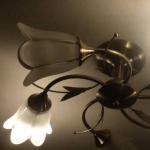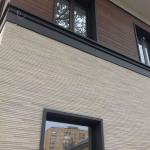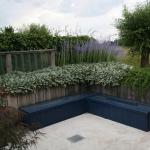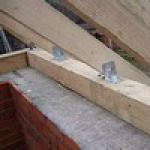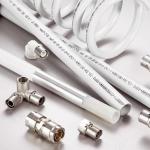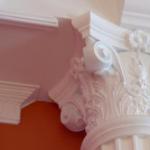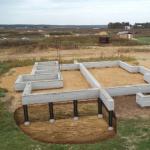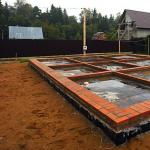Roofing roll material is the most popular way to finish the roof of any country house. The modern market offers a wide selection of materials, each of which is good in its own way. What to give preference and what to look for when choosing?
Main categories
All roll materials for roofing are divided depending on the type of base into basic or baseless. According to the type of components of the coating composition, they are bitumen, polymer or bitumen-polymer. The base can be cardboard, asbestos, polymers, fiberglass or a combination of materials, and the protective layer has a fine-grained, coarse-grained or fiberglass structure. All these types of rolled roofing materials are widely used in construction. Consider the features of each type in more detail.
Bituminous: cheap and easy
Glassine is another material created from roofing paper and impregnated with bitumen. The material is thin and less durable compared to roofing material, so it is most often used as a lining.
Built-up roofing materials
Built-up roofing is an excellent solution for arranging the roofs of buildings, structures in the field of industrial and civil construction. Such materials are suitable for waterproofing both roofs and foundations, floors and ceilings. Rolled roofing welded material is easy to install, so a large amount of work can be done in just a day. Its peculiarity is that rot-resistant fiberglass or fiberglass is used as the basis, which increase strength.

As bitumen modifiers, polymers are used, which increase resistance to various influences and increase strength. Rolled roofing welded material is characterized by high elasticity, flexibility at low temperatures and high heat resistance. An important role in the welded materials is played by the structure of the top layer, whose task is to protect the roof. The roof covering should serve as protection against heating, ultraviolet radiation, precipitation. To minimize this effect, sprinkle coating is used.
Rolled roofing waterproofing welded material most often has a dressing of different fractions - coarse-grained or fine-grained, scaly or dusty. Basalt, slate, sand, ceramic chips are used as raw materials. When choosing, you should focus on several factors:
- The complexity of the relief of the roof structure, as well as the angle of its slope.
- temperature regime in the region.
- The amount of precipitation that falls on average per year.
- Possible loads that can lead to deformation.
Bituminous materials for waterproofing
A number of roofing materials serve not only to cover the structure, but also for its high-quality waterproofing. Among them - metalloizol. This material has a three-layer structure: bitumen - foil - bitumen. This is a durable roofing that shows excellent performance properties, has high strength and reliability.

No less popular is a bituminous rolled roofing and waterproofing material called isol. Rubber, mineral sealants, antiseptic and polymer additives are added to it during production. Such a composition serves as a guarantee that the material will show increased heat resistance. Suitable for flat shape and overlays. On the basis of asbocellulose, a hydroisol is created, the main difference of which is increased rot resistance. It is widely used in waterproofing basements and areas that are poorly ventilated.
Thus, roofing bituminous rolled and built-up materials are a wide range of coatings that are made in the form of canvases and can be used in various areas of construction. The secret of their popularity is their affordable cost, as well as increased resistance to various influences.
Bitumen-polymer materials
If the bottom layer in the form of a binder is glued to the welded roofing, it will show good waterproofing properties. Rolled roofing waterproofing welded material most often has a binder component in the form of roofing bitumen and fillers in the form of polymer additives, which increase the service life and performance properties.
It leads to an increase in heat resistance and a decrease in frost resistance of the coating. To avoid such phenomena, atactic polypropylene (APP) or styrene-butadiene-styrene elastomers (SBS) are added. In this way, polymer-bitumen rolled roofing material is obtained. It costs more, but excellent performance properties combined with high reliability and durability will appeal to many owners of country houses.
Features of bitumen-polymer materials for roofing

Two-component roofing materials in the form of rolls have recently been in high demand. They consist of bitumen and polymer, the volume of which is about twelve percent. The basis for this type of coating is polyester, fiberglass, crumb rubber or thermoplastic. Such roofing roll material has a number of features:
- High plasticity.
- Crack resistance.
- Possibility of operation in different temperature ranges.
- High strength.
- Reduced brittleness temperature.
- Elevated softening point.
The use of bitumen-polymer types of coating is advisable when building a flat or pitched roof with a maximum slope of twenty-five degrees. Otherwise, the coating may slip. Roll roofing materials for the top layer based on bitumen and polymers are presented in several types.
"Monoflex"
This is a multilayer material consisting of polyester, a film, polymerized bitumen as a base and a coating in the form of ceramic chips. Thanks to modified additives, performance can be improved. This material comes in a number of varieties, the most popular of which are Copprflex with an inert copper outer layer and Aluflex with an aluminum outer layer. These coatings are characterized by high heat resistance and durability.
"Isoplast"
Material rolled roofing "Isoplast" consists of polymerized bitumen and a base in the form of polyester or fiberglass. It is available in two varieties - roofing and lining. The top layer has a coarse topping on the front side and a polyethylene film on the other, and the bottom layer is a polyethylene film, which is coated on both sides with a fine-grained fraction topping. Such a structure of the material contributes to the fact that it acquires flexibility, resistance to bending and cracking. The polymer film on the bottom serves to protect the coating and guarantee its safety.
Other bitumen-polymer materials

Any roofing roll material based on bitumen and polymers has a number of advantages:
- The high quality of the binder component is the key to reliability under any temperature changes.
- High elasticity results in improved flexibility at low temperatures.
- The coating has good adhesion to the powder.
Among the materials popular in construction, rolled roofing of the Technoelast series can be noted. They are produced by double-sided application of a bitumen-polymer binder to a polyester or fiberglass base. It, in turn, consists of bitumen, SBS modifier and mineral filler in the form of talc or dolomite. And the protective layer is created on the basis of sprinkling of different fractions and a polymer film. The covering is widely applied in creation of a roofing carpet in various buildings which are operated in any climatic conditions.
Polymer roll roofing materials
Rolled polymer roofing material is created on the basis of petroleum resins or rubber. These types of coatings belong to a new generation and have durability and high reliability. Their service life reaches twenty years or more, and roofs of any configuration can be covered with them - flat, pitched, gently sloping, and even with round slopes. Laying is carried out by strip or continuous gluing on the basis of adhesive mastic, and the preparation of the substrate plays an important role. Some materials are secured by weight or mechanical means.
polymer membrane
This is a modern roofing roll material, which is increasingly used in the repair and decoration of the roof. Its popularity is due not only to high reliability, but also to a wide range of colors, resistance to temperature extremes and durability, which reaches forty years. This innovative material is a single-layer roof, which is made from flexible polyvinyl chloride by hot air welding. This roofing is:
- resistance to ultraviolet radiation;
- immunity to the most adverse weather conditions;
- resistance to various bacteria, chemically aggressive substances;
- resistance to rotting and decomposition;
- the possibility of creating a coating with a breathable effect.
All this distinguishes this rolled roofing material (GOST is set in the technical documentation) from others.
Types of polymer membranes
PVC-based membranes are the most common in Russia. They consist of polyvinyl chloride, to which plasticizers are added. Their purpose is to increase frost resistance and give elasticity. A special reinforcing base gives reliability and strength, while the seam sections are strong and tight.

Membranes based on thermoplastic polyolefins are an innovative material in which components are added that improve the fire-prevention and operational properties of the surface. Such membranes are characterized by a combination of the advantages of PVC and rubber. Therefore, they are better combined with bitumen. And this, in turn, affects the greater strength of the material.
EPDM-based membranes have high elasticity and the ability to operate under the most extreme conditions for a long time. They are produced reinforced and unreinforced, which is necessary to increase the strength and reliability of the material. Moreover, any variety is characterized by elasticity and strength. The kit consists of additional parts with which you can waterproof difficult areas - sealants, fasteners.
Roofing materials by class
Depending on the durability, all roofing bituminous materials are divided into several types:
- premium (service life - 25-30 years);
- business (service life - 15-25 years);
- standard (service life - 10-15 years);
- economy (service life - 10 years);
- sub-economy (service life no more than five years)
The premium-class materials include the Technoelast series. Features of these coatings - the ability to create a breathable roof, from which moisture will be removed, which has the ability to reduce the durability of the roof. With the help of materials of this type, it is possible to equip a single-layer roofing, solving the problem with swelling and making the installation itself easier and more convenient. For the arrangement of the lower layer of the roofing, you can use "Technoelast Fix", which makes it possible to mount the roofing carpet on the base. The roof will be resistant to deformation and able to withstand heavy loads. The operational features of the coating are such that it can be used in regions with any climatic conditions.
Two business-class materials can be distinguished - "Uniflex" and "Ecoflex". The first is good because it serves as an effective protection against moisture penetration, contributing to the durability of the structure. Both materials are a waterproofing sheet that provides roof ventilation. "Ecoflex" is an excellent solution for underground structures. This roofing roll material is advisable to use in regions with elevated temperature conditions. Due to its quality and reliability, it will serve as roof protection for quite a long time.
Among the materials of the standard class, "Bipol" is in demand. It has a strong, non-rotting base, which is coated on both sides with a high-class bitumen-polymer binder. On the basis of this material, it is possible to equip a roof with a small slope, waterproof the foundations of buildings and structures.
The economical types include "Linocrom K", with the help of which the top layer of the roofing carpet is equipped. It can be used as a vapor barrier in the bottom layer of the system. Its protective layer is made with fine-grained dressing or polymer film.
"Bikrost" is a popular material, which is a waterproofing sheet with a solid base based on a bituminous binder. It is used when installing the lower layer of the roofing carpet. The protective layer is provided with a fine-grained dressing or film. The cheapest roofing roll material is glassine. It is a roofing cardboard, which is additionally impregnated with oil bitumen. On the basis of this material, it is possible to repair and equip roofs with a service life of a maximum of five years.
conclusions
As you can see, modern manufacturers offer a wide selection of roofing roll materials. Each of them has its own technical and operational features, each is designed for a specific roof structure. That is why it is so important to take into account the composition, application features and climatic conditions of your own region. All this together will allow you to choose the most suitable building material for specific conditions.
We are glad to welcome you on the site of the roofing company "Stroy-Alliance"
The main and priority activity of our organization is the high-quality performance of work on the installation and repair of flat roofs. We will reliably carry out the following works:
|
Laying gasket and built-up vapor barrier. |
|
 |
Each type of these plates has its own advantages and disadvantages. Call us and we will offer you the brand of insulation that is right for you. |
 |
We will perform work on creating slopes from expanded clay or using wedge-shaped thermal insulation. |
 |
Installation of cement-sand and prefabricated screeds. |
 |
Reliable brands of roofing waterproofing. No fiberglass as the basis of the rolls. Only fiberglass and polyester. The traditional technology for the repair of soft flat roofs includes the fusing of roofing roll materials using gas burners. This method of installing and repairing flat roofs is intuitive and has been used for over 30 years. The practical experience of performing such work by the specialists of our organization is 17 years. As a roofing we use high-quality materials of the TechnoNikol company. |
 |
Polymer-bitumen grades with a thickness of more than 6 mm (with two-layer laying) The service life of the roll coating is from 15 years. Strict adherence to the technology of work. |
 |
Domestic and imported polymeric membranes. All accessories for installation are available. Three automatic welding machines. Crews with 10 years of experience in PVC membrane roofing. |
 |
Operational visit to the object. Reliable troubleshooting. The roofers of Stroy-Alliance are certified by TechnoNikol. |
 |
We will draw up a commercial offer according to the technical task or defective statement within 1 working day. If necessary, we will calculate the cost at state rates. |
 |
|
 |
|
In our activities we use only proven technologies and use materials that have passed many years of testing in real operating conditions. In principle, we do not work with materials that have low technical performance and a short service life. We supply the main materials to the object, directly from the manufacturing plants, bypassing intermediaries.
We offer potential Customers various methods of work performance. This also applies to the optimization of grades of materials, and technologies used in the installation of roof structures. We know how to save money without losing quality!
Do you want the repair or installation of a flat roll roof to be carried out with high quality, without violations of technology and in a short time?
Call now or leave a request and our roofers will get down to business!
Benefits of cooperation with Stroy-Alliance
Stroy-Alliance is proud of its team. Due to the fact that we do not have a "staff turnover", over the years of our existence, the company's employees have gained invaluable experience, studied in Russian and foreign companies. All this guarantees that our specialists will prevent errors, take into account every nuance in the work and provide a high-quality product as a result. Stroy-Alliance specialists clearly fulfill their obligations under the contract, so our company is considered a reliable partner. Expensive modern equipment that we use for installation, repair of flat, soft, built-up, bituminous roofing, laying of rolled roofing, waterproofing of the roof is the advantage of Stroy-Alliance, as this allows us to minimize the time of work without loss of quality.

- More than ten years is our experience with PVC membranes. We provide our services at a wide variety of facilities: shopping malls, warehouse terminals, private homes;
- Installation of membrane roofing is carried out in the shortest possible time (from 500 square meters per day);
- Quick budgeting, preparation of a full package of documents when putting the object into use (acts of acceptance of work performed, acts of hidden work, etc.);
- Installation of a rolled roof made of PVC membranes, repairs, installation of a built-up flat roof are carried out by us throughout the Central Federal District of Russia;
- The work of Stroy-Alliance fully complies with tax legislation (when concluding a work contract, VAT is deducted);
- Installation, repair of a flat roof is carried out using a variety of methods (modern and traditional);
- Departure of a technical specialist is carried out with maximum efficiency and completely free of charge;
- Brands of materials used are agreed with the Customer;
- When providing services, we use the latest foreign equipment;
- Citizens of the Russian Federation work in the brigade.
Leave your roof repair worries on the shoulders of our specialists!
Liquid polymer roofing is a relatively recent invention, so it has not yet received wide distribution, but its popularity is growing every year. Polymeric materials are beginning to compete with traditional roofing, which is not surprising, given their technical characteristics.
The main advantages of arranging liquid polymer roofs include:
High rates of waterproofing;
Resistance to temperature fluctuations, such a coating is able to withstand a temperature range ranging from -50 to +120 degrees Celsius;
Excellent indicators of reliability and wear resistance;
Seamless;
Resistance to exposure to sunlight;
Long service life, which lasts at least 15 years;
Ease of installation.
Installation of a polymer roof, as well as self-leveling floors, is not particularly difficult. If you have certain knowledge, it is quite possible to carry it out on your own, and it begins with the preparation of the base, which is completely cleaned of foreign elements and thoroughly dried. Bituminous, latex or bitumen-rubber mastic can act as a material. To improve adhesion, the surface can be treated with a primer, which is bitumen diluted in kerosene.

After preparing the base, the first layer of mastic is applied, to which fine gravel is added, when the material has completely hardened, you can start applying the next layer. Between them, you can lay a reinforced mesh, if necessary, with the selected device method. The thickness of the layers must be controlled and constantly kept within 2 mm. The number of layers depends on the developed technology, the last layer is covered with gravel, which gives it additional protection.
The self-leveling roof can be equipped independently, in which case the cost of its installation will depend solely on the cost of the material itself. The price of roofing mastic varies between 280-510 rubles per 1 kg. According to the norms, the consumption per 1 square meter of the base is about 8 kg of polymer material.
Roof waterproofing with liquid rubber
In urban architecture, more and more preference is given to a flat roof, for the repair of which it is necessary to solve some problems. To make a high-quality repair of a flat roof, it is necessary to use materials that have absolute waterproofing and are resistant to temperature extremes. Moreover, such materials should serve at least a period of ten years. This should take into account the fact that the material should be available on the market and had a low cost. In Europe and the USA, liquid rubber has been successfully used as such a material over the past twenty years.
Liquid rubber is an elostameric water emulsion that is produced from petroleum derivatives with the addition of certain polymers. Such material is designed for waterproofing roofs of various configurations, in particular for flat roofs.

Liquid rubber should be applied by airless spray, i.e. cold method. The material can be applied to both vertical and horizontal surfaces. After application, liquid rubber becomes a seamless and homogeneous polymer membrane on the roof surface. At the same time, there are absolutely no holes on the roof.
After applying liquid rubber to the roof, the latter becomes protected from corrosion of any origin. Let it be ultraviolet, acid rain, ozone, sea water and other substances that cause corrosion. The membrane has high qualities of waterproofing, vapor barrier and gas insulation.
Important! When applying liquid rubber, the surface must be freed from various inclusions, the surface must be clean and dry. This is necessary to eliminate the adhesion of the membrane.
Liquid rubber also has very good mechanical resistance and elasticity. So when stretched by 1350%, it is able to restore 95% of its original shape. Therefore, liquid rubber can serve for twenty years or more.
This material is produced in accordance with all safety standards. Liquid rubber is environmentally friendly and does not contain organic solvents and various volatile substances. It is odorless, non-toxic and fireproof.
Liquid rubber is used in industrial and civil construction. It can cover both soft and hard roofs. It is also often used in the repair of gutters or local repair of the roof.

Liquid rubber can be of various colors. Therefore, when repairing the roof of various buildings (sheet or other roofing), the roof will look very beautiful. The thickness of the membrane is 2-3 mm, and 1500 square meters can be processed in one day. m. The weight of all equipment is 68kg. And if you consider that liquid rubber lasts many times longer than other soft materials, it also weighs and costs less, then we can conclude: this is an ideal material for roofing.
No less famous in the modern market of building materials is liquid rubber Slavyanka. It has all the advantages of this material, which allows it to find a large number of applications in the construction process. This material is applied by the hot method, and not only on new buildings, they also repair the roof with liquid rubber.
Liquid self-leveling roofing can be one-component or two-component in its composition. Liquid self-leveling roofing is used for the installation of new roofs, as well as for the repair and reconstruction of old roofs. Liquid self-leveling roofing is a seamless coating.

The composition includes a reinforcing layer (fiberglass, fiberglass) and a waterproofing layer (polymer or bitumen-polymer mastics). Liquid self-leveling roofing can be applied both mechanically and manually. Liquid self-leveling roofing is arranged on a base of concrete or reinforced concrete slabs, cement-sand mortar screeds, and metal, wood, insulation boards and others can also serve as the basis. Liquid self-leveling roof after hardening is a rubber-like monolithic material that can withstand sudden changes in temperature, heavy precipitation, exposure to aggressive solutions, ultraviolet radiation. High-quality self-leveling roof can be arranged in any weather conditions. The liquid self-leveling roof proved to be good in a harsh climate. Liquid self-leveling roofing requires a professional approach to its installation, in which case it will provide reliable protection for the building.
Liquid roof device
Atmospheric precipitation and humidity are the main causes of deterioration of the roof and the entire structure of the house. The device of a bulk roof allows to provide reliable protection of the building from external adverse factors.

Liquid roofing can be made on a base consisting of concrete or reinforced concrete slabs, cement-sand mortar screed, wood, metal coating, insulation boards, roll coating, flat slate, thereby explaining the wide popularity of liquid liquid roofing. Before starting the installation of a self-leveling roof, it is necessary to treat the top layer of the base with solvent-based roof paints. The device of a bulk roof is applied both in housing, and industrial construction. Self-leveling roofing is a one-component or two-component composition that is applied to the roof surface in a bulk way. The device of a bulk roof can be made under any weather conditions. Self-leveling roofing has shown itself especially well in areas with a harsh climate. The device of a self-leveling roof, made in compliance with technological norms and rules, allows you to achieve a monolithic coating. Self-leveling roofing made of polymer mastics is vapor-permeable, resistant to temperature extremes, ultraviolet radiation, and aggressive environments.
Liquid roofing is also called cold roofing because it does not need to be warmed up before installation. The basis of such a roof is liquid rubber, which, due to its plasticity, does not let water through. But it is also not cheap, so a low budget is unlikely to pull it. But the price of this roofing material is justified, because it allows you to forget about the roof for a long time after installation.

Among the advantages of a liquid (cold) roof there are many advantages:
· Durability;
No need for fasteners and some kind of clips;
· Lightweight roofing material;
· Plastic allows to apply a roof on any kind of a roof with any bends;
No seams after installation (which increases water resistance);
· Resistance to an ultraviolet;
· Fire resistance;
· Environmentally friendly material;
Good adhesion to other roofing elements of the roof;
· Fast and easy repairs.
Since the cold roof is based on liquid rubber, it can be used not as a roofing material, but to seal the joints of other roofing materials, which will almost completely reduce the chance of moisture penetrating through the waterproof sheet.
Until recently, roofing material and bituminous mastic were mainly used for waterproofing. Modern offers of materials are much wider and allow you to choose the method that suits all the criteria. One of the most sought after is a rubber-based liquid finish.

What is liquid waterproofing?
Liquid roof waterproofing is a new and improved material based on a bituminous emulsion in combination with latex particles. The finished solution does not contain volatile substances harmful to humans, so it meets high environmental standards. Immediately after application, the mass hardens in a matter of minutes and creates a monolithic polymer web. Liquid rubber has the following characteristics (properties and qualities): elastic and flexible coating, high level of hydrostatic strength, resistance to heavy loads (up to 70 kg), resistance to ultraviolet rays, acid rain and ozone, hardening without the use of roof heating or a burner, high the level of vapor tightness and water tightness of the roof, a high level of breakdown strength, safety and cleanliness of the material from an environmental point of view, the absence of elements of easy flammability in the composition of the material and, as a result, a high level of fire safety, instant hardening (80%), long service life, up to fifteen years or more.
If we talk about the shortcomings of a liquid roof, it should be noted that they actually do not exist. With proper installation roofing work and compliance with all necessary building codes and technologies, this type of roof will not have significant disadvantages during operation.

Liquid Roof Tips
It is necessary to thoroughly clean the entire roof surface in order to maintain a high level of tightness and proper waterproofing. When applying liquid rubber to a concrete or metal surface, priming with polyurethane primers should be ensured. They must be applied in several layers, between which quartz sand should be sprinkled.
To achieve a high-quality result, you should entrust the installation of a liquid roof to specialists in the field of construction, who have rich experience and all the necessary knowledge and skills.
Benefits of liquid roof waterproofing
Waterproofing the roof with liquid rubber brings many advantages both directly during the application process and during the operation of the building. The main advantages of this material are as follows:
Possibility of finishing the roof of any design and configuration;
high degree of strength and wear resistance;
excellent elasticity;
no need to prepare the solution yourself;
formation of a seamless coating over the entire processing area with a thickness of 3 mm;
excellent adhesion to any type of base material - wood, concrete, brick, block and metal structures, all types of decorative finishing material for roofs;
variability of processing methods, which allows you to choose the best one for specific professional skills and construction time;
· high speed of drawing and hardening;

Immunity to destruction at constant temperature drops - from -60C up to 110C;
non-toxicity;
Durability - standard service life of at least 50 years;
the ability to quickly identify and easily eliminate defects - irregularities, cracks, chips, recesses in the coating in case of their formation;
high levels of moisture resistance;
does not interfere with natural air circulation;
high level of frost resistance.
Important! The cost of liquid roof waterproofing is affordable for any builder. In combination with the above important properties, it is easy to conclude that this is a truly universal solution in all respects for any direction in the construction of buildings. We will not replace such material at all if you have increased requirements for incombustibility and frost resistance and at the same time there is no time for a long and thorough preparation of the base.
Which roof is suitable for liquid waterproofing?

Despite the fact that the price of liquid roof waterproofing is low, it is used for arranging pitched, hip and flat roofs of the following types of buildings:
industrial buildings, warehouses, pavilions, hangars;
Shopping malls, shops
Residential private and multi-storey, multi-apartment buildings;
theaters, circuses, rest houses and sanatoriums;
administrative premises.
Important! When making waterproofing on commercial or large-scale premises, they resort to the help of specialized specialists, but when arranging your own home, you can easily save on additional costs of money if you make liquid roof waterproofing with your own hands. This process is not difficult and will not take much time, including if the roof surface is embossed.
Liquid rubber application technology: methods
Application methods are distinguished by two criteria:
the tools used to carry out the work;
the type of material itself.
To create a durable and reliable coating, choose the inventory that will be more convenient and understandable for you to use - these are:
airless pumping unit for spraying;
Roller or brush for painting.

Important! The second option will be more labor-intensive, therefore it is suitable for processing a small area of \u200b\u200bthe roof surface. At the same time, the first involves additional costs for the purchase or rental of special equipment. Be sure to consider these factors before deciding which one to prefer.
According to the second criterion, liquid rubber is distinguished for roof waterproofing of the following types:
· cold;
hot.
Important! In this regard, when choosing, be guided by the following conditions. Cold applied material is easier to handle and does not require a clear time frame in the process of use. Hot waterproofing will suit you if the level of professional building skills is high enough and there is already a practice of using such solutions.
Liquid waterproofing of the roof: instructions
Like any other construction process, you have to perform roof waterproofing in several successive stages:
1. Make the correct calculation of the required amount of material and buy it.
2. Prepare the base.
3. Apply solution.
4. Check the quality of the work performed before further arrangement of the roof.

Important! To carry out the full scope of work, choose a day with good weather - clear, with an air temperature of at least + 5C, so that there is no ice or stagnant puddles in the bumps on the roof.
How to calculate the amount of liquid rubber?
This procedure is very simple. All you need is:
1. Look at the package consumption of the solution indicated by the manufacturer.
2. Correlate this data with the area of \u200b\u200byour roof.
Important! If there is no such data on the package, adhere to the standard consumption parameters of 1 kg per 3-4 square meters of surface, provided that the mortar is applied in 2 layers (these data are given for the cold type of mortar). Add 10% overspending to the resulting figure and you will get the exact rate for finishing your roof.
How to properly prepare the base?
In order not to reduce the quality of adhesion and not create the need to re-register the waterproofing and the entire roof in the future, prepare the base using the following technology:
1. Check for frame defects.
2. Remove all large and small debris from the roof.
3. Remove dust by wet mopping the surface.
4. Maintain a technical pause until completely dry.
How to apply liquid waterproofing mechanically?

To get a quality result and really reduce the time spent, do the work in this way:
1. Prepare airless equipment.
2. Check the accuracy of its configuration.
3. Prepare a container with a solution of calcium chloride.
4. Attach containers with a solution of liquid rubber and calcium chloride to the installation.
5. Simultaneously pump out two mixtures and apply the solution to the roof surface in such a way that a layer 3-4 mm thick is formed.

Important! When using such equipment, not only the whole process is significantly accelerated. You will also be able to appreciate the cost-effectiveness of this solution by reducing the consumption of the bulk of the liquid rubber. The highest efficiency was noted when using equipment UND-01, RX-27, TechnoProk B-21, Pazkar RK-10. Such systems do not fail for a long time, which means that you do not have to spend extra money on their repair.
How to apply liquid waterproofing manually?
This method, although more laborious, is fully justified if it is necessary to finish the space of a small area or there are no time limits. The application procedure is not difficult:
1. Prepare a paint roller or a wide brush.
2. Consistently coat the surface of the base with a mortar thickness of 2-4 mm.
3. When using a hot application solution, preheat a small batch to 220-230C and cool to 160C.

4. After creating one layer, take a technical break of up to 10 minutes so that the liquid rubber completely polymerizes.
5. Apply the next 1 or 2 coats in the same way.
6. Check for large surface elevation differences and voids.
7. Proceed to the further design of the roof.
As you have already seen, there are no difficulties in the process of creating a liquid roof waterproofing. The main condition is the choice of high-quality material that will ensure the integrity of your roof for a long period. When buying, consider the recommendations of experts on this criterion, who prefer trusted manufacturers of the following brands:

TechnoNikol;
liquid rubber;
· Ultramast;
· Rapidflex;
· Slavyanka.
Water-displacing polymer composition for repair and restoration of roofs made of various materials. Allows you to work in all weather conditions. It is used for the construction of flat self-leveling roofing. The easiest way to repair the roof of a garage, house, bath.
Indispensable for seasonal work in the housing sector
Fix leaks at any time.
Features and Benefits:
No need to waste time and money on drying and surface preparation.
You don't need to buy a primer.
You don't have to wait for the right weather.
Emergency repairs are acceptable in rain and snow.
Easy to use. It is applied to the damaged area, and the repair is completed.

Properties:
Plastic material with good adhesion to soft, slate or metal roofing.
It is used both on dry and wet surfaces, and even under a layer of water.
Displaces water from the processed surface, evenly filling all deepenings and damages.
Restores up to 10 mm of the old coating (soft roof).
Can be used in sub-zero temperatures (up to -15C).
Composition color: black.
Release form: can (2.4 kg).
Apply with a brush.
The basis of liquid roofing material is bitumen. Also, the composition of this material contains plasticizing additives, mineral and polymer components.
Liquid roofing material has excellent plasticity and excellent adhesive qualities. But in order for the material to perform its functions, it must be correctly applied to the surface of the base.
When performing waterproofing work using liquid roofing material, follow these instructions:
1. When choosing a brand of liquid roofing material, give preference to PBK-1 material. It contains a special thermoplastic elastomer component, which, when mixed with bitumen, prevents the material from cracking under the influence of severe frost or scorching sunlight.

This brand of liquid roofing material is more often used for the final coating of the roof. But for priming the base, it is better to take lower-quality brands of liquid roofing material - MBI or MRBI. Before applying to the surface, they must be mixed with solvents until the composition acquires good fluidity.
2. In the diluted state, the liquid roofing material acquires excellent flow characteristics, and this makes it possible to prime the roof surface well before applying the base layer.
3. Liquid roofing material does not require the use of a hot method for its application. The material is simply diluted with a solvent in the desired consistency.
4. The density of the liquid roofing material is determined depending on the quality in which the roofing material will be applied to the surface. If this is a primer composition, then it is desirable that the material be rarer. And, conversely, for the main coating, the roofing material is prepared thicker.
5. To dilute liquid roofing material, a special liquid is used - a hydrocarbon solvent.
6. To apply liquid roofing material to the surface, special painting tools are used. Its uniform distribution over the surface is carried out using a rubber squeegee.

7. If all the work is done correctly, then you get a smooth, seamless coating that resembles rubber in its structure.
Do-it-yourself liquid roofing material
Liquid roofing material is more often used in repair work. It is used to seal joints, cracks, seams on the old roll coating. It is possible to complete the arrangement of the roof with liquid roofing material on your own, with your own hands.
To apply a liquid material, various painting tools (rollers or brushes) are used, but to facilitate work and more evenly distribute the composition over the surface, it is better to use a spray gun (spray gun). Immediately after drying, the liquid roofing material forms a perfectly even and smooth surface, without seams and cracks.
Usually, liquid roofing material has a dark shade, but if necessary, the consumer can order the material of the desired color so that the roof blends harmoniously with the surrounding landscape.
Roofing with liquid roofing material is carried out in the following sequence:
1. The surface to be treated is well cleaned and dried. If there are any irregularities on it, then you can prepare a cement-sand mortar and level it.
2. If liquid roofing material is used to repair an old roof, then before applying it, all exfoliated old rolled material must be removed. Where there is swelling of the old roofing material, you need to lift the roll lining, dry the space under it well, then prime with liquid roofing material and glue with bituminous mastic.

3. Before applying liquid roofing material, the entire work surface must be primed using mastic diluted with a solvent.
4. A layer of liquid roofing material is applied to a well-dried base surface. If it is necessary to make several layers of waterproofing during work, then each subsequent layer is applied after the previous one has thoroughly dried.
The use of liquid roofing material
The scope of liquid roofing material is quite wide. This material is made on the basis of liquid rubber and is an excellent alternative to conventional rolled roofing material.
Liquid roofing material has several advantages that make it popular in the building materials market. These benefits include:
· Easy installation. The material does not need to be heated in order to fix on the surface. Application to the substrate is carried out using tools such as a roller, paint brush or sprayer. After the liquid roofing material has completely dried, the roof takes the form of a monolithic and smooth carpet, on which there is not a single joint or seam.
· Small consumption of material, small monetary costs for restoration.
· Liquid roofing material is produced by manufacturers in a convenient form (buckets from 1 to 200 liters).

The durability of the material is determined by the presence of polymer components, plasticizers and mineral additives in its composition.
· Liquid roofing material well protects the processed surface from an atmospheric precipitation.
Liquid roofing material is used in various fields:
· As a waterproofing material for foundations, roofs, basements and other underground structures.
· As a restoring material for asphalt pavement, roll bituminous roofing.
· As a protective anti-corrosion coating for steel structures. Also see:
· As a basis for creation of soft roofs (with armature or without it).

The modern market of building materials is constantly being improved, and the use of new inventions provides an increase in the expected results while minimizing costs. One clear example is polymer roofing.
Polymeric coatings of a flat roof have only one goal - to protect against the penetration of precipitation in the form of rain, snow, hail.
What kind of materials are used in the production of such coatings and why are they better than other types of roofs? The main characteristic that a polymer roof should have is strength and long-term operation.
Roof installation work is quite expensive, so it is only natural for a homeowner to look for a roof covering that can be used for a long period without repair.
Coatings, from which polymer roofing materials are made, very quickly won the construction market and consumer confidence due to their exceptional performance characteristics:
- high strength;
- elasticity;
- flexibility in relation to environmental influences;
- resistance to mechanical damage;
- no need to purchase equipment for subsequent care during use.
Polymer membrane roof

Membranes and liquid mastics can act as independent finishing roof coverings, or be inside a roofing pie, for example, as part of an inverted roof.
Polymer roofing membranes are extremely popular, as they are used to build very durable and interesting roof coverings. This is ensured by a large range of colors and fairly wide roll materials, which minimizes the number of necessary seams.
There are three main types of polymer membranes on the modern market:
- EPDM (EPDM);
- TPO (TPO);
- PVC-P (PVC).
EPDM is made from synthetic rubber and has been around for a long time. The very first roofs covered with this material have been used for 40 years. The EPDM membrane is very light in weight and flexible. When installing the coating, specially designed self-adhesive tape or glue is used.
PVC membranes are of high quality, elasticity and long service life. Typically, during production, these membranes are reinforced with a polyester mesh. Individual "flakes" are connected by hot air welding. Compounds that increase resistance to the sun and precipitation are added to the top layer of the roofing membrane.
TPO membranes are made from rubber and polypropylene. Usually, when organizing, membranes with reinforcement are chosen, which are more durable. The connecting seams are formed by welding.
Of the three listed types, PVC and TPO are more popular today. Membrane alignment can be done in three ways:
- hot air welding;
- heating wedge welding;
- solvent diffusion bonding.
When carrying out the last type of welding, a specially designed solvent is applied to the previously cleaned and dried surface, and a load is placed on top.

The overlap of the mounted membranes must be at least 50 mm, and the width of the welded seam must be at least 30 mm.
Welding is carried out with hot air using a building hair dryer or a welding machine. In this case, the fastening of the first sheet is carried out mechanically.
The use of PVC and TPO membranes is due to the frequent need for a durable and at the same time fast roof installation process. Also, these materials meet the highest fire safety requirements.
Of course, there is a cost disadvantage: the price of polymer membranes is approximately 30% higher than that of polymer-bitumen materials. But this fact is offset by a longer service life, manufacturers guarantee 10-20 years, and experts predict up to 50 years without repair.
Another method of installing a polymer roof is self-leveling. With this coating, there are no seams, and its composition contains waterproofing (usually polymer mastic) and reinforcement (usually fiberglass).

The basis for the installation of a self-leveling roof can be concrete and reinforced concrete slabs.
The base for the self-leveling roofing material should be made of concrete or wooden floors, cement screed, metal, and a layer of insulation. It is possible to carry out installation on the previous polymer-bitumen coating or.
Reflective performance is improved by coating with specially designed paints.
At the end of the roofing work, the roof covering is similar to a monolithic material such as rubber.
The positive aspects should be noted the absence of a seam connection, high strength and elasticity, ease of installation, resistance to atmospheric phenomena, long-term operation, vapor tightness.
The essence of a self-leveling roof made of polymeric materials is similar to membranes. The only difference is that the preparation and application of the mixture is carried out at the installation site.
Two types of materials are used for self-leveling roofing: polymer-rubber and polymer coating. Most often today, the second option is used with a large number of advantages.
Installation of a self-leveling roof is quite simple. The base is preliminarily prepared, and the prepared composition is applied to it and evenly distributed by means of a spatula or roller.
The most important advantage of such a roof is complete tightness. Elasticity does not allow the polymer coating to deform under the influence of temperature changes.
To date, one of the types of such a coating has gained popularity - a self-leveling polyurethane roof. This material is easy to use, even if there are difficult areas such as air ducts, pipes, etc. Polyurethane helps organize the integrity of the rubber-like coating.
This type of roofing material perfectly copes with the action of various aggressive environments and atmospheric phenomena, and the long term of its operation is ensured by polyester fabric.
Polyurea for roof construction and repair
Another type of bulk material made of polymer is polyurea. Its origin is organic.
By opting for such a coating, you will not fail with its reliability: its wear resistance is higher than that of ceramic floor tiles.
So, polyurea is a material of very high quality in order to organize waterproofing during construction work.
The positive characteristics of polyurea, which gives it an advantage over other materials, are:
- quick setting (polymerization) - within 1 hour;
- possibility of installation at high humidity and cold (up to -15 °С);
- resistance to sunlight and high ambient temperatures;
- electrical insulation;
- high long-term operation;
- compliance with fire safety requirements (self-extinguishing material);
- environmental friendliness.
Thus, the use of new polymeric materials helps to reduce the installation time of roofs, which subsequently have excellent performance characteristics - strength and durability.
The modern construction market provides a wide selection of various roofing materials. One of the innovative solutions is polymer roofing.
It is one of the most popular materials for finishing the roofs of buildings. This material allows you to cover the structure of various sizes without seams or with a minimum of them.
Types of polymer roofing materials
To date, there are several options for roofing on a polymer base. The main types include:
- Membrane polymer roofing;
- Bulk polymer roofing.
Membrane option allows the use of polymeric material on roofs with a complex shape and design. Roofing is a roll of a certain size, which is attached to the surface of the building with the help of hot air. In this case, the design is neat and monolithic. Such a roof is not afraid of temperature changes, and also does not allow condensation to form. That is why this type of roofing is used in the construction of prefabricated houses.
There are three main types of polymer membranes on the market today. These are EPDM, PVC and TPO.
EPDM began to be produced many years ago from synthetic rubber. Today, roofs covered with this material are over 40 years old. EPDM has good elasticity and low weight. During the installation of this material, special glue or self-adhesive tape is used.
PVC membranes are distinguished by long service life, elasticity and excellent quality. Polyvinyl chloride is used for their production. Most of this material is reinforced with polyester mesh. In its upper layer there are special compositions, thanks to which it is not afraid of sunlight, rain and snow.
TPO membranes Made from polypropylene and rubber. For membrane roofing, as a rule, a reinforced membrane is chosen, since it has greater strength. TPO membranes are environmentally friendly, they do not contain volatile components. During installation, the connecting seams are welded with a jet of hot air.
Concerning bulk type roofing polymer coating, then it is a material similar to rubber. With this option, there are no seams, and additional substances such as polymer mastics and fiberglass are materials for reinforcing this coating. The self-leveling type of roof is airtight, elastic, durable and easy to install.
When arranging a self-leveling roof, polymer or polymer-rubber coatings are used. Today, polymer coatings are more popular, as they have many advantages.
Distinctive characteristics of a polymer roof
The widespread use of polymer-type roofing in modern construction is due to the special advantages of the material.
Polymer membrane roofing:
- High level of fire safety;
- Protection against formation of condensate;
- Strength;
- Elastic characteristics;
- Long service life (more than 20 years);
- Ease of installation;
- Resistance to various climatic conditions;
- Aesthetic look.
Liquid polymer roofing has the following advantages:
- Monolithic construction;
- Excellent strength indicators;
- Elasticity;
- Temperature resistance
- Long service life;
- Water resistance.
Concerning shortcomings polymer roofing materials, this includes:
- High cost of coverage;
- Release into the air when laying harmful volatile chemicals.
Installation
Roofing with polymeric materials is quite simple. Installation of a polymer roof is carried out using one of the following methods:
- gluing;
- Ballast system;
- Fastening mechanically;
- The "rail on the seam" system.
When laying on a flat roof, most use a ballast system. Polymer sheets are placed on the base, and the joints are welded to prevent water from entering. After that, the membrane is fixed around the perimeter and rubble, pebbles or other ballast are poured on top. Thanks to such a system, it is possible to cover a large area with one sheet, as well as carry out repair work on a polymer roof without dismantling the old coating.
If the roof is sloping, does not have parapets and drains, polymer roofing materials are mechanically fastened. In this case, rails are used. "Rail on the seam" is well suited for those roofs that have a non-standard shape, as well as where additional wind resistance is needed.
Installation of polymer roofing on roofs with a large slope is carried out by gluing. This installation method is the easiest. In addition, it provides good wind resistance.
Bulk polymer roofing is also quite easy to install. To do this, it is only necessary to evenly distribute the liquid consistency of the material over the roof surface.
Maintenance and repair
This type of coating is quite good in operation and does not require special care. However, in the case of the use of poor-quality materials or illiterate installation, certain repairs are possible.
Taking into account the peculiarities of the reconstruction of polymer roofs, as well as the need for certain knowledge and skills, only an experienced specialist should carry out repairs and maintenance of roofs with this type of coating.
Dismantling of the coating
The dismantling of the polymer roofing should be carried out by specialists. The fact is that most of the materials that are used to guess the membrane or bulk roofs, when removed, can release chemicals harmful to the human body. That is why the work must be done only in a certain sequence and with the use of protective measures.
Summary
Polymer roofing is a new way of processing roofs. The material has excellent indicators of strength, term of operation and protection of the building from the effects of climatic conditions. The advantages of polymer roofing are also ease of installation and aesthetic appearance of the finished roof.
